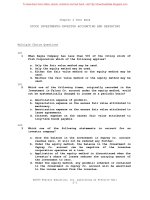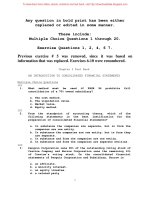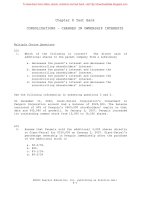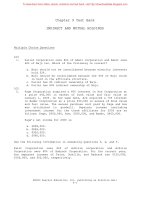Test bank strategic staffing 2e by philips gully chapter 03
Bạn đang xem bản rút gọn của tài liệu. Xem và tải ngay bản đầy đủ của tài liệu tại đây (98.18 KB, 10 trang )
Strategic Staffing, 2e (Phillips/Gully)
Chapter 3 The Legal Context
1) Complying with staffing laws enhances an organization's ability to appeal to a broader
customer base.
Answer: TRUE
2) Someone who provides their services to a firm as part of an independent business is
considered an employee of that firm.
Answer: FALSE
3) Employers are not liable for the acts of their employees during the time of their employment.
Answer: FALSE
4) Contingent workers are part of a company's core workforce.
Answer: FALSE
5) Any employee of a temporary agency working at another company's place of business is not
entitled to receive benefits from the company.
Answer: TRUE
6) Seasonal employees are employees hired to work only during a particular part of the year.
Answer: TRUE
7) Seniority-based promotions make leadership competencies important hiring criteria even for
lower-level positions.
Answer: TRUE
8) An independent contractor performs services and the employer controls or directs only the
result of the work.
Answer: TRUE
9) Executive Order 11246 prohibits discrimination and establishes affirmative action to promote
diversity.
Answer: TRUE
10) Facially neutral means that all employees and applicants are treated consistently, regardless
of their protected characteristics, such as their sex and race.
Answer: TRUE
11) Affirmative action plans give preferential treatment to the qualified applicant on a permanent
basis.
Answer: FALSE
12) Anyone who submits a resume or an employment application over the Internet is considered
an applicant.
Answer: FALSE
1
Copyright © 2012 Pearson Education, Inc. Publishing as Prentice Hall
13) In a mixed motive case of disparate treatment, the employer is accused of having both a
legitimate and an illegitimate reason for making the employment decision.
Answer: TRUE
14) Disparate impact occurs when an action has a disproportionate effect on a protected group,
regardless of intent.
Answer: TRUE
15) It is legal to compare an applicant's scores only to members of his or her own racial subgroup
and set separate passing or cutoff scores for each subgroup.
Answer: FALSE
16) Which of the following is true for employment contracts?
A) To be enforceable, an employment contract must be in writing.
B) An oral contract is implicit, while a written contract is explicit.
C) They give employees the upper hand in the employment relationship.
D) An implicit contract is not specified in a written or verbal contract.
Answer: D
17) Employment-at-will is an employment relationship which ________.
A) allows either the employee or employer to terminate the employment at any time
B) offers blanket protection to employers for all employee discharges
C) allows an employer to terminate employment only for a just cause
D) offers employees a contract for a definite term of employment
Answer: A
18) Which of the following are employees of a company who take on the operation of certain
functions, or staff an entire office or factory on a contractual basis for a client or company?
A) contingent workers
B) at-will employees
C) leased workers
D) independent contractors
Answer: C
19) Which of the following is true of a "closed shop"?
A) Employers encourage unions to form.
B) Employees need not remain union members after they are hired.
C) No non-union workers are employed.
D) Employees must give up union membership once employed.
Answer: C
20) Which of the following was declared illegal by the Taft-Hartley Labor Act?
A) open shop
B) union shop
C) agency shop
D) closed shop
Answer: D
2
Copyright © 2012 Pearson Education, Inc. Publishing as Prentice Hall
21) Which of the following is a characteristic of independent contractors?
A) They have a continuous relationship with the employer.
B) They do not receive benefits from the employer.
C) They control the processes and results of their work.
D) They do not pay their employment taxes, the employer does.
Answer: B
22) The WARN Act of 1988 applies to ________.
A) employers with up to 100 employees, not including part-time workers
B) regular local, federal, and state government entities that provide public services
C) private, public, and quasi-public entities which operate in a commercial context
D) employers with employees who work less than 20 hours per week
Answer: C
23) Department store BigTen refused to hire Max because of his religion. The store is in
violation of ________.
A) the WARN Act
B) the USERRA of 1994
C) Title VII of the Civil Rights Act of 1964
D) the VEVRAA Act of 1974
Answer: C
24) The Age Discrimination in Employment Act of 1967 protects people ________.
A) 30 years of age or older
B) 40 years of age or older
C) 50 years of age or older
D) 60 years of age or older
Answer: B
25) The WARN Act relates to which of the following?
A) recruiting
B) selecting
C) negotiating
D) layoffs
Answer: D
26) The Uniformed Services Employment and Reemployment Rights Act ________.
A) ensures that members of the uniformed services can return to their civilian employment after
their service ends
B) ensures that veterans are equally represented in the workforce
C) provides job training to members of the uniformed services to assist them in transitioning to
civilian jobs
D) requires that a job board be maintained for the sole use of veterans transitioning to civilian
jobs after their service ends
Answer: A
3
Copyright © 2012 Pearson Education, Inc. Publishing as Prentice Hall
27) A BFOQ is a(n) ________.
A) requirement for establishing a case of discrimination
B) exception to employment-at-will relationship
C) characteristic that is essential to the performance of an employment function
D) analysis of a firm's competitive advantage
Answer: C
28) Affirmative action means ________.
A) proactive efforts to ensure nondiscriminatory results in employment practices
B) employment practices are designed and used in a "facially neutral" manner
C) employers must meet quotas to ensure employee diversity
D) protection for employees against retaliatory discharge
Answer: A
29) Which of the following is true for affirmative action plans?
A) An affirmative action plan should not be remedial in nature.
B) An affirmative action plan should exclude all nonminorities.
C) An affirmative action plan should be temporary.
D) An affirmative action plan does not need to be formalized.
Answer: C
30) Mrs. Peters filed a complaint against her employers for firing her. She admitted to being late
to work five days in a month but she claimed that she was fired on the grounds of being a female
employee. This is an example of ________.
A) fraudulent recruitment
B) mixed motive case
C) adverse impact
D) negligent hiring
Answer: B
31) A manager only hires Hispanic women as secretaries. This is an example of ________.
A) disparate treatment
B) disparate impact
C) negligent hiring
D) sexual harassment
Answer: A
32) What is the best conclusion given the following information about research technicians
employed in the scientific wing of a pharmaceutical organization? Females comprise 60 percent
of the current workforce and 50 percent of the relevant population (research technicians) and
males comprise 40 percent of the current workforce and 50 percent of the relevant population.
A) There is a disparate impact on males as research technicians.
B) There is a disparate impact on females as research technicians.
C) There is no evidence of disparate impact among research technicians.
D) There is evidence of disparate impact against both males and females as research technicians.
Answer: A
4
Copyright © 2012 Pearson Education, Inc. Publishing as Prentice Hall
33) Comparing the percentage of men, women, or minorities employed in a job category with
their availability in the relevant population of qualified people interested in the position is an
example of a ________.
A) bona fide occupational qualification
B) concentration statistic
C) flow statistic
D) stock statistic
Answer: D
34) If 33 percent of Hispanics are hired, 42 percent of whites are hired, and 50 percent of blacks
are hired, disparate impact has occurred against ________.
A) Hispanics
B) whites
C) Hispanics and whites
D) None of the groups
Answer: A
35) A hotel chain that is recruiting front desk receptionists receives 200 applications from males
and 100 applications from females. 100 out of 200 men are hired and 25 out of 100 women are
hired. Which of the following statements is true of the hotel chain's hiring policy?
A) There is evidence of a disparate impact of the hiring process on males as a group.
B) There is evidence of a disparate impact of the hiring process on females as a group.
C) There is no evidence of any disparate impact.
D) There is evidence of disparate impact against both males and females.
Answer: B
36) Comparing the percentage of applicants hired from different subgroups to determine if they
are significantly different from each other is an example of a ________.
A) BFOQ
B) concentration statistic
C) flow statistic
D) stock statistic
Answer: C
37) Comparing the percentages of men, women, or minorities in various job categories to see if
men, women, or minorities are disproportionately represented in certain workforce categories is
an example of a ________.
A) hiring yield statistic
B) concentration statistic
C) flow statistic
D) stock statistic
Answer: B
5
Copyright © 2012 Pearson Education, Inc. Publishing as Prentice Hall
38) If a company makes promises to a recruit that it does not intend to keep, it could be found
guilty of ________.
A) negligent hiring
B) negligent referral
C) fraudulent recruitment
D) violating the WARN Act
Answer: C
39) A company fails to do a background check that would have revealed that a person it has
hired has the potential to harm others. The employee then physically harms a customer during a
disagreement. The company could be found guilty of ________.
A) negligent hiring
B) negligent referral
C) fraudulent recruitment
D) violating the WARN Act
Answer: A
40) When a competing hospital calls for an employee recommendation, a hospital manager fails
to disclose negative information about a previous employee who was discharged for improper
and reckless behavior toward a patient. This could be an example of ________.
A) negligent hiring
B) negligent referral
C) fraudulent recruitment
D) violating the WARN Act
Answer: B
41) Dylan worked for Sun Pharmaceuticals as a scientific research assistant. He quit the
company and joined Kip Pharma Industries as a senior researcher. Sources at Sun discovered that
Dylan had sold some trade secrets belonging to the company to Kip Pharma. In this situation,
which of the following statements is true?
A) Sun Pharmaceuticals can litigate against Dylan for trade secret violation.
B) Kip Pharma can sue Sun Pharmaceuticals for allowing Dylan to quit.
C) Dylan can sue Sun Pharmaceuticals for causing him financial loss.
D) Kip Pharma can sue Dylan for trade secret violation.
Answer: A
42) When Mary hires someone because they share the same interests, which of the following has
occurred?
A) stereotyping
B) like-me bias
C) prejudice
D) hiring manager bias
Answer: B
6
Copyright © 2012 Pearson Education, Inc. Publishing as Prentice Hall
43) "All men are strong" is an example of which type of bias?
A) like-me bias
B) stereotyping
C) prejudice
D) ignorance
Answer: B
Diff: 1
Page Ref: 75
Skill: Application
Objective: 5
AACSB: Analytic skills
7
Copyright © 2012 Pearson Education, Inc. Publishing as Prentice Hall
44) The Equal Employment Opportunity Commission imposed compensatory damages on Czar
Microsystems Pvt. Ltd. for discriminating against an employee on the basis of their age. Czar
defended itself by claiming to be unaware of any such law. This is a(n) ________ defense.
A) erroneous
B) stereotyping
C) prejudice
D) ignorance
Answer: D
45) How is at-will employment best used by employers?
Answer: At-will employment is an employment relationship in which either party can terminate
the employment relationship at any time, for any legal reason, with no liability as long as there is
no contract for a definite term of employment. Although at-will employment allows an employee
to quit for no reason, firms call upon it most often when they want to fire an employee at any
time for any legal reason or for no reason at all. In all states (except Montana), if a formal
contract does not govern a company's employment relationships, these relationships are
governed by the "employment-at-will" doctrine.
Although the courts have generally upheld the right to terminate at will, this does not mean that
employers should casually terminate employees without giving a reason or without following
normal policies and procedures. Companies should follow their formal discipline and termination
procedures whenever possible to help avoid discrimination and wrongful termination claims. The
at-will clause is best thought of as a legal defense to keep the organization from being forced to
follow its own policies inflexibly. For example, at-will employment allows an employer to
quickly dismiss an employee who is behaving dangerously. Case law establishing when or if
firms can rely on the at-will nature of the relationship varies from state to state.
Diff: 2
Page Ref: 50-51
Skill: Concept
Objective: 3
8
Copyright © 2012 Pearson Education, Inc. Publishing as Prentice Hall
46) Compare and contrast outsourcing to independent contracting from the perspective of a
company that needs to fulfill an order within a short duration. Which method is better if the
company in question is using an innovation-based low-cost strategy?
Answer: Independent contractors must make their own Social Security contributions, pay
various employment taxes, and report their income to state and federal authorities. From a legal
perspective, whether a worker is an employee or an independent contractor with respect to the
company determines the obligations the company has to the worker. If an employee is
incorrectly classified as an independent contractor instead of an employee, the company can be
liable for employment taxes for that worker, plus a penalty.
An alternative to contingent work is outsourcing the work to another firm. This typically
involves contracting with an outside firm that has particular expertise to assume complete
responsibility for a specific contracted service not just to supply workers. Firms often outsource
their noncore functions, such as their payroll, landscaping, and food service activities.
Offshore outsourcing by opening a location in another country or outsourcing work to an existing
company abroad has become increasingly popular for many organizations seeking productivity
gains. Companies can strategically use independent contractors to help control costs, temporarily
increase capabilities, and bring in needed talents quickly. They can thus be particularly useful for
companies competing through innovation or low-cost strategies. Independent contractors often
receive a higher salary than do regular employees but do not receive benefits, which can make
them cost-effective.
Diff: 2
Page Ref: 53-54
Skill: Synthesis
Objective: 2
AACSB: Reflective thinking skills
9
Copyright © 2012 Pearson Education, Inc. Publishing as Prentice Hall
47) What is affirmative action? What is an affirmative action plan?
Answer: Affirmative action is the proactive effort to eliminate discrimination and its effects, and
to ensure nondiscriminatory results in employment practices in the future. Affirmative action
began as a supplement to the Civil Rights Act's promise to end race discrimination in
employment.
An affirmative action plan describes in detail the actions to be taken, procedures to be allowed,
and standards to be adhered to, to establish an affirmative action program. Affirmative action
plans can include, but are not limited to, provisions for nondiscriminatory recruitment, training,
and promotion. Procedures for internal record keeping, auditing, and reporting are often included
to ensure compliance and measure the program's success.
Affirmative action plans must apply to everyone, regardless of their age, gender, race, creed,
physical ability, or national origin. It assures that everyone has an equal opportunity to compete
for all employment benefits and to participate in all employer-sponsored programs based on
individual merit, which must be determined by criteria which are applied equally to everyone,
and which do not systematically favor one group over another.
Affirmative action programs may give preferential treatment to qualified applicants from
underrepresented protected groups. Numerical benchmarks are usually established based on the
availability of qualified applicants in the job market or qualified candidates in the employer's
workforce. These numerical goals do not create quotas for specific groups, nor are they designed
to guarantee proportional representation or equal results. A contractor's failure to attain its goals
is not in and of itself considered to be a violation a failure to make good faith efforts to attain
the goals is.
Diff: 2
Page Ref: 62
Skill: Concept
Objective: 4
48) What are quota staffing systems and how are they used?
Answer: Quota staffing systems establish specific requirements that certain percentages of
disadvantaged groups be hired to equalize their proportional representation in the company's
workforce with their proportions in the job and organization's relevant labor market. The size and
location of an organization's relevant labor market depends on the nature of the job. As an
illustration, for faculty positions, the relevant labor market is usually defined as national. For
management and professional positions, the relevant labor market is generally defined as
regional. For staff and laborer positions, the relevant labor market is usually defined as local.
The law does not require quotas or even preferential treatment. Employers are not required to
have proportional representation in their workforce, but they are more open to lawsuits if they do
not. Although affirmative action, preferential treatment, and quotas are not required by law, they
are not prohibited either. Quotas have been found to be illegal in a number of courts cases so
there are limitations on their features and usage. A quota is most often used as a court-imposed
remedy for past discrimination or as part of a voluntary affirmative action plan.
Diff: 2
Page Ref: 63
Skill: Concept
Objective: 4
10
Copyright © 2012 Pearson Education, Inc. Publishing as Prentice Hall









